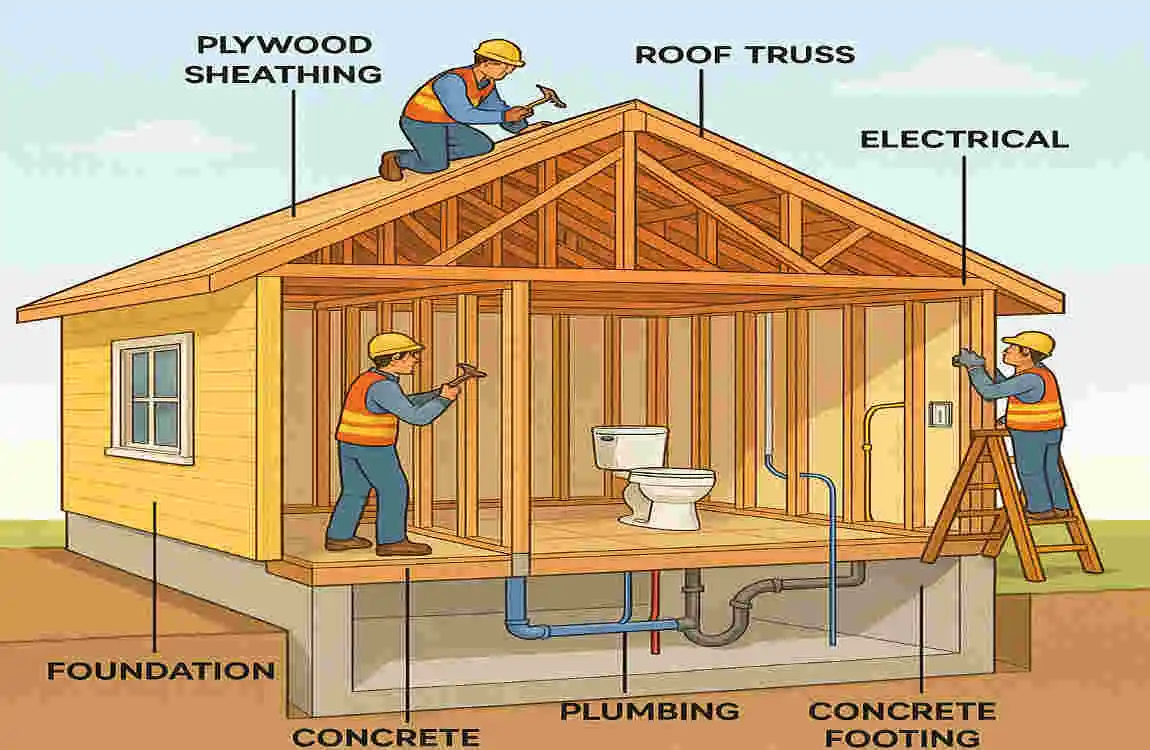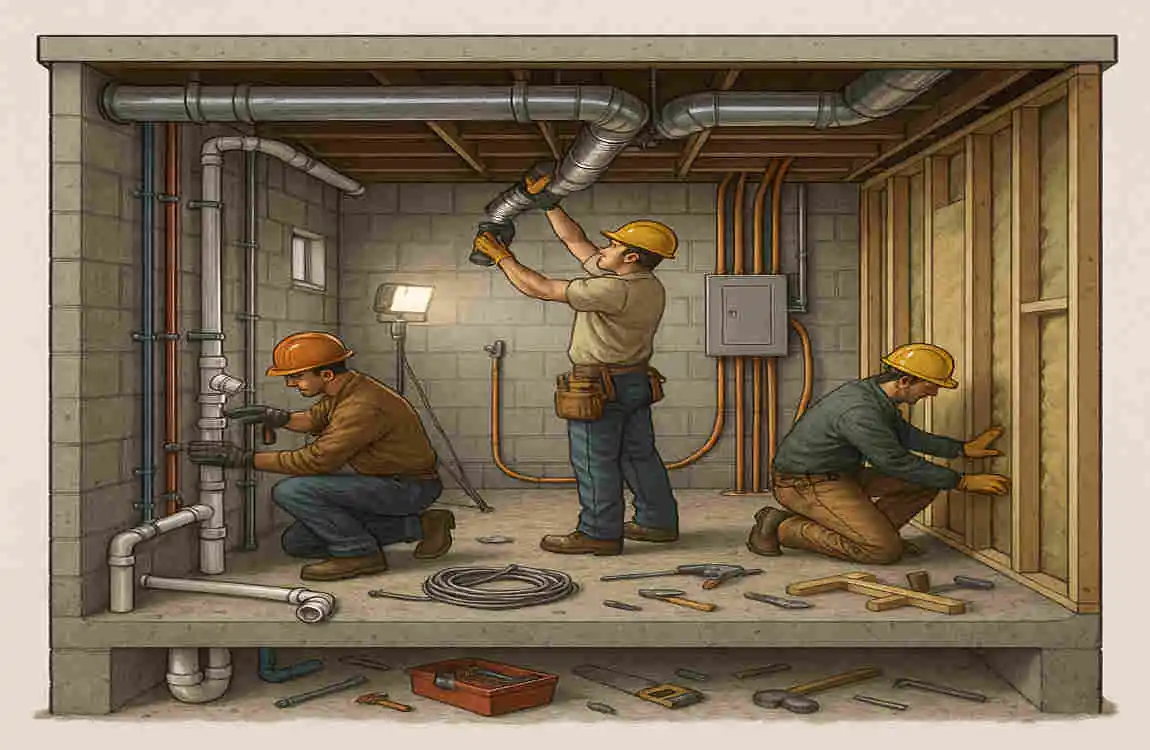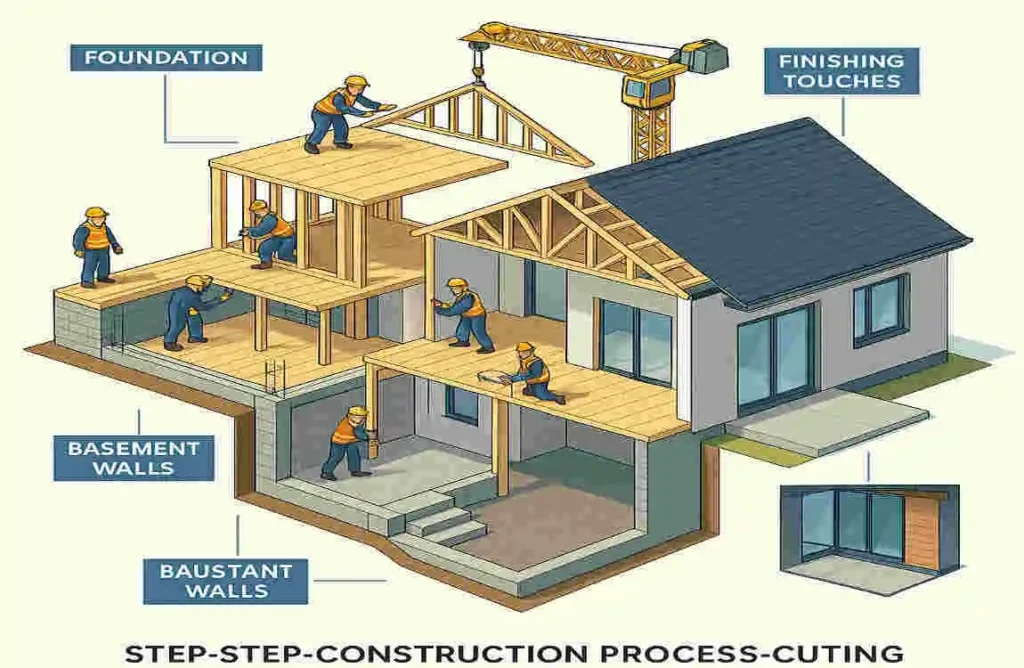Are you dreaming of a home that combines the ease of single-storey living with the added space and versatility of a basement? You’re not alone! Modern home construction trends increasingly favor 1-storey houses with basements for their unique blend of functionality and style.
Whether you’re a first-time homebuyer, a seasoned investor, or simply curious about the construction process, this article will provide you with the knowledge you need to make informed decisions. We’ll cover everything from the basics of 1-storey house design to the intricacies of basement excavation and utility installation. By the end, you’ll have a clear understanding of what it takes to build your dream home.
Understanding the Basics of 1 Storey House Construction

What is a 1 Storey House?
A 1-storey house, also known as a single-storey or ranch-style home, is a residential structure with only one level above ground. These homes are popular for their accessibility, affordability, and flexible design options.
Advantages of Single-Storey Living
- Accessibility: With no stairs to navigate, 1-storey homes are ideal for individuals with mobility issues or young families with young children.
- Cost: Single-storey construction often requires less material and labor compared to multi-storey homes, potentially saving you money.
- Design Flexibility: The open floor plan of a 1-storey house allows for creative and adaptable layouts that can be easily modified to suit your changing needs.
Enhancing Space and Utility with a Basement
Integrating a basement into your 1 storey home design can significantly increase your living space and provide additional utility. Basements can serve as extra bedrooms, home offices, entertainment areas, or storage spaces, making them a valuable addition to any modern home.
Structural Considerations
When planning a 1 storey house with a basement, it’s crucial to consider the structural elements that will support your home. This includes the foundation, load-bearing walls, and overall layout. Proper planning and engineering are essential to eansure the stability and longevity of your home.
Designing a 1 Storey House with a Basement
“How is a 1 storey house construction and basement designed?” begins with understanding the unique challenges and opportunities presented by this type of home. By working closely with architects and engineers, you can create a design that maximizes the potential of your property while adhering to local building codes and regulations.
Planning and Design Phase
Site Selection and Soil Testing
The first step in building your 1-storey house with a basement is selecting the correct location. Consider factors such as lot size, topography, and utility access. Once you’ve chosen a site, it’s essential to conduct a thorough soil test to assess the ground’s stability and suitability for basement construction.
Designing for the Future
When designing your home, it’s essential to think about your current and future needs. Consider how your family may grow or change over time and how your home can adapt to those changes. This may include planning for additional bedrooms, a home office, or accessible features.
Working with Professionals
Collaborating with experienced architects and engineers is crucial to creating a successful 1-storey house with a basement. These professionals can help you develop detailed blueprints, including basement plans, ensuring your home meets all necessary building codes and standards.
Permitting and Legal Considerations
Before breaking ground, you’ll need to obtain the necessary permits and approvals from your local government. This process can vary by location, so it’s essential to research the specific requirements and timelines for your area.
Key Design Elements for Modern Basements
When designing your basement, consider incorporating the following elements to maximize its functionality and appeal:
- Natural Light: Strategically placed windows and light wells can help bring natural light into your basement, making it feel more inviting and spacious.
- Waterproofing: Proper waterproofing is essential to protect your basement from moisture and potential flooding. Work with your contractor to ensure that your basement is sealed correctly and drained.
- Flexible Layout: Design your basement with a flexible layout that can be easily adapted to different uses over time. This may include open-concept spaces, movable walls, or modular furniture.
Planning and Design: The Foundation of Your Home
The planning and design phase is a critical step in the process of “how a 1-storey house construction and a basement are undertaken in contemporary housing.” By carefully considering your needs, working with professionals, and obtaining the necessary permits, you’ll set the stage for a successful construction project.
Excavation and Foundation Work
The Excavation Process
Once your plans are finalized and permits are in place, it’s time to begin excavation. This involves excavating the area where your basement will be, taking care to remove any obstacles and to prepare the ground for the foundation.
Choosing the Right Foundation
There are several types of foundations suitable for 1-storey houses with basements, including:
- Slab Foundation: A slab foundation is a solid concrete slab that rests directly on the ground. This type of foundation is often used in areas with stable soil conditions.
- Crawl Space Foundation: A crawl space foundation elevates the home above the ground, providing access to utilities and storage space. This type of foundation is suitable for areas with high water tables or poor soil conditions.
- Full Basement Foundation: A full basement foundation creates a usable space below the main level of the home. This type of foundation requires the most excavation and is ideal for maximizing living space.
Waterproofing and Drainage
During the foundation work, it’s essential to Install proper waterproofing and drainage systems to protect your basement from moisture. This may include applying waterproof coatings to the exterior of the foundation walls, installing drainage pipes, and grading the surrounding soil to direct water away from the home.
Concrete Pouring and Curing
Once the foundation is in place, it’s time to pour the concrete. This process involves carefully mixing and pouring the concrete into the foundation forms, ensuring that it’s level and free of air pockets. After the concrete is poured, it must be allowed to cure for a specified period, typically several days to a week, depending on the weather conditions.
Inspections and Quality Control
Throughout excavation and foundation work, it’s essential to conduct regular inspections to ensure the work is being done correctly and in compliance with code. This may involve hiring a third-party inspector or working closely with your contractor to ensure that all necessary steps are taken.
Excavation and Foundation: The Bedrock of Your Home
The excavation and foundation work are crucial steps in the process of “how a 1-storey house construction and basement are undertaken in contemporary housing.” By carefully planning and executing this phase, you’ll create a solid foundation for your home that will support you for years to come.
Structural Framing and Walls Construction
Framing the 1 Storey Structure
Once the foundation is complete, it’s time to start framing the 1-storey structure above the basement level. This involves constructing the skeleton of your home using a combination of wood, steel, or concrete blocks, depending on your design and local building codes.
Materials Used in Framing
- Timber: Wood framing is a popular choice for 1 storey homes due to its affordability, flexibility, and ease of construction.
- Steel: Steel framing offers increased durability and resistance to fire, pests, and rot, making it an excellent choice for homes in certain climates or regions.
- Concrete Blocks: Concrete block construction provides added strength and stability, particularly in areas prone to high winds or seismic activity.
Building Basement Walls
As you frame the main level of your home, you’ll also need to construct the basement walls. These walls will provide structural support and help to separate the basement from the rest of the house. Depending on your design, you may choose to use concrete blocks, poured concrete, or insulated concrete forms (ICFs) for your basement walls.
Reinforcement Techniques
To ensure the stability and longevity of your basement walls, it’s important to incorporate proper reinforcement techniques. This may include using steel rebar, fiber mesh, or other reinforcing materials to strengthen the walls and prevent cracking or shifting over time.
Insulation and Vapor Barriers
As you construct your basement walls, it’s crucial to Install proper insulation and vapor barriers to protect against heat loss and moisture intrusion. This may involve using foam board insulation, spray foam, or other materials to create a thermal barrier between the basement and the outside environment.
Framing for Energy Efficiency and Structural Integrity
The way you frame your 1-storey house with a basement can significantly impact its energy efficiency and structural integrity. By using proper techniques and materials, you can create a home that is both comfortable and durable, saving you money on energy bills and maintenance costs over time.
Framing and Walls: Building the Bones of Your Home
The process of “how is a 1-storey house construction and basement undertaken in contemporary housing” continues with the framing and construction of the walls. By carefully selecting your materials and techniques, you’ll create a solid foundation for the rest of your home.
Installing Basement Utilities and Interior Preparation

Plumbing, Electrical, and HVAC Considerations
As you prepare your basement for use, it’s important to consider installing essential utilities, such as plumbing, electrical, and HVAC systems. These systems will provide the necessary water, power, and climate control to make your basement a comfortable and functional space.
Sump Pumps, Radon Mitigation, and Moisture Control
To protect your basement from potential water damage and health hazards, it’s crucial to Install systems such as sump pumps, radon mitigation, and moisture control. A sump pump can help to remove excess water from your basement, while radon mitigation systems can reduce the levels of this harmful gas. Moisture control measures, such as dehumidifiers and proper ventilation, can help to prevent mold growth and maintain a healthy indoor environment.
Interior Basement Wall Finishing Options
When it comes to finishing your basement walls, you have several options, depending on your desired look and level of moisture resistance. Some popular choices include:
- Drywall: A cost-effective, versatile option for finishing basement walls. However, it may not be suitable for areas with high moisture levels.
- Cement Board: Cement board is a more durable and moisture-resistant alternative to drywall, making it ideal for basements.
- Paneling: Wood or composite paneling can add a warm, rustic touch to your basement, but may require additional moisture protection.
- Tile: Tile is highly durable and moisture-resistant, making it a good choice for basement walls, especially in areas like bathrooms or laundry rooms.
Preparing the Basement for Versatile Uses
One of the most significant advantages of having a basement in your 1 storey home is the ability to use the space for a variety of purposes. By carefully planning and preparing your basement, you can create a space that can serve as a:
- Living Area: With the right finishing touches, your basement can become a comfortable and inviting living space for your family and guests.
- Storage Space: Basements are ideal for storing seasonal items, holiday decorations, and other belongings that you don’t need to access frequently.
- Home Office: If you work from home or need a quiet space for studying, your basement can be transformed into a functional and private home office.
- Entertainment Area: From a home theater to a game room or bar, your basement can be the perfect place to entertain friends and family.
Setting Up Utilities: Bringing Your Basement to Life
The process of “how is a 1-storey house construction and basement undertaken in contemporary housing” continues with the installation of utilities and the preparation of the interior space. By carefully planning and executing these steps, you’ll create a basement that is both functional and comfortable, adding value and versatility to your home.
Roofing, Exterior Work, and Finishing Touches
Roof Design for 1 Storey Houses with Basements
When it comes to roofing your 1 storey house with a basement, you have several options to choose from, depending on your desired style and climate. Some popular choices include:
- Gable Roof: A gable roof features two sloping sides that meet at a central ridge, creating a classic and timeless look.
- Hip Roof: A hip roof has four sloping sides that meet at a central point, providing added stability and resistance to high winds.
- Flat Roof: A flat roof can be a cost-effective and modern option for 1 storey homes, particularly in areas with mild climates.
Exterior Cladding and Weatherproofing
To protect your home from the elements and enhance its curb appeal, it’s essential to choose the right exterior cladding and weatherproofing materials. Some popular options include:
- Vinyl Siding: Vinyl siding is a durable, low-maintenance, and affordable option for exterior cladding.
- Brick or Stone: Brick or stone veneer can add a timeless, elegant touch to your home’s exterior while also providing insulation and durability.
- Fiber Cement: Fiber cement siding is a versatile and weather-resistant option that can mimic the look of wood, brick, or stone.
Window and Door Installation
When installing windows and doors in your 1 storey house with a basement, it’s essential to consider both functionality and aesthetics. For basement-level openings, choose windows that let in natural light while maintaining privacy and Security. Some popular options include:
- Egress Windows: Egress windows are larger windows that provide a safe exit route from the basement in case of an emergency.
- Hopper Windows: Hopper windows open inward from the top, allowing for ventilation while maintaining Security.
- Casement Windows: Casement windows open outward on a hinge, providing maximum ventilation and easy cleaning.
Landscaping and Driveway Considerations
As you complete the exterior work on your home, don’t forget to consider landscaping and driveway options. Proper landscaping can enhance your home’s curb appeal and provide a welcoming outdoor space, while a well-designed driveway can improve accessibility and functionality. Some ideas to consider include:
- Front Yard Landscaping: Planting trees, shrubs, and flowers can add color and interest to your front yard, while also providing shade and privacy.
- Backyard Oasis: Creating a comfortable and inviting backyard space can extend your living area and provide a place for relaxation and entertainment.
- Driveway Materials: Choose a driveway material that complements your home’s style and meets your needs, such as asphalt, concrete, or pavers.
Final Inspections and Certifications
Before moving into your new 1-storey house with a basement, it’s essential to complete all necessary final inspections and obtain any required certifications. This may include:
- Building Inspections: Your local building department will conduct a final inspection to ensure that your home meets all necessary codes and standards.
- Electrical and Plumbing Inspections: Separate inspections may be required for your home’s electrical and plumbing systems to ensure their safety and functionality.
- Occupancy Permit: Once all inspections are complete and any issues are resolved, you’ll need to obtain an occupancy permit before moving into your new home.
Finishing Touches: Putting the Final Pieces in Place
The process of “how is a 1-storey house construction and basement undertaken in contemporary housing” concludes with the installation of the roof, exterior cladding, windows, and doors, as well as the completion of landscaping and final inspections. By carefully attending to these finishing touches, you’ll create a home that is not only functional but also beautiful and inviting.
Cost Estimates, Timeline, and Common Challenges
Typical Cost Breakdown
Building a 1-storey house with a basement can be a significant investment, but the exact cost will depend on factors such as location, size, materials, and finishes. Here’s a rough breakdown of the typical fees you might expect:
- Land Purchase: $50,000 – $200,000
- Site Preparation and Excavation: $5,000 – $20,000
- Foundation and Basement Construction: $20,000 – $50,000
- Framing and Structural Work: $30,000 – $70,000
- Roofing and Exterior Finishes: $20,000 – $50,000
- Interior Finishes and Utilities: $50,000 – $100,000
- Landscaping and Driveway: $5,000 – $20,000
Remember that these are rough estimates, and your actual costs may vary. It’s always a good idea to get multiple quotes from contractors and to build in a contingency fund of 10-20% to account for any unexpected expenses.
Expected Construction Timeline
The timeline for building a 1-storey house with a basement can vary depending on factors such as the home’s size, the design’s complexity, and the availability of materials and labor. Here’s a rough breakdown of the typical phases and their durations:
- Planning and Design: 2-6 months
- Permitting and Approvals: 1-3 months
- Site Preparation and Excavation: 1-2 weeks
- Foundation and Basement Construction: 2-4 weeks
- Framing and Structural Work: 4-8 weeks
- Roofing and Exterior Finishes: 2-4 weeks
- Interior Finishes and Utilities: 8-12 weeks
- Landscaping and Driveway: 1-2 weeks
Overall, you can expect the entire construction process to take anywhere from 6 months to a year or more, depending on the specifics of your project.
Common Challenges and Solutions
Building a 1-storey house with a basement can present unique challenges, but with proper planning and execution, they can be overcome. Some common issues to watch out for include:
- Water Seepage: Basements are prone to water seepage, particularly in areas with high water tables or poor drainage. To prevent this, ensure your foundation is properly waterproofed and that your lot is graded to direct water away from the house.
- Soil Issues: The stability of your soil can have a significant impact on the foundation of your home. Conduct a thorough soil test before beginning construction and work with your contractor to address any issues that arise.
- Permit Delays: Obtaining the necessary permits and approvals can sometimes take longer than expected, delaying the start of construction. To minimize this risk, work closely with your local building department and submit your applications as early as possible.
Hiring Experienced Contractors
One of the best ways to ensure a successful 1-storey house with basement construction project is to hire experienced, reputable contractors. Look for professionals who have a proven track record of completing similar projects on time and within budget. Don’t be afraid to ask for references and to thoroughly vet any potential contractors before signing a contract.

